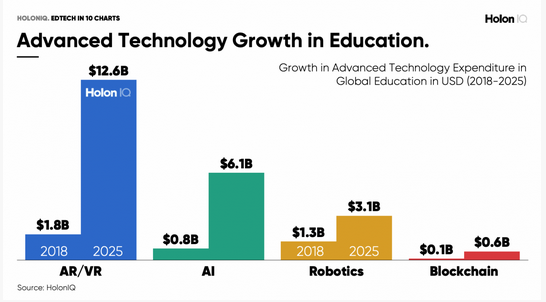Global Spending on Virtual Reality, AI in Education Poised to Skyrocket, Report Says
Global spending on artificial and virtual reality in education is expected to soar from $1.8 billion to $12.6 billion annually over the next four years, a new analysis projects.
Spending on artificial intelligence in education, meanwhile, will jump from $800 million to $6.1 billion yearly over that same period, according to the report released recently by HolonIQ, a global research and intelligence firm.
The report made several projections for global ed-tech expenditures in K-12, higher education, and corporate training through 2025. Those include forecasts of total education spending, upskilling, spending on digital technologies as a proportion of total education spending, and venture capital investment.
“AR/VR is coming down the stack from workforce into higher ed, and is slowly making its way into K-12,” Patrick Brothers, the co-CEO and co-founder of HolonIQ, said in an interview.
Augmented and virtual reality has seen only modest uptake yet in K-12 because there’s a big learning curve for students and teachers to become familiar with the technologies, and because their use will take some time to catch on, he said.
Other areas of advanced technology figure to see significant growth in expenditures through 2025, include robotics and blockchain, according to the report. It projects that the total spent on robotics will rise from $1.3 billion in 2018 to $3.1 billion in 2025, and that the total spent on blockchain will rise from $100 million in 2018 to $600 million in 2025.

The biggest driver for the use of blockchain in education is a desire for secure and scalable credentialing, while the biggest spark behind the use of robotics in education is schools looking for different ways to engage learners in STEM fields, Brothers said.
HolonIQ forecasts overall global spending on ed-tech to rise from $227 billion in 2020 to $404 billion in 2025.
Currently, spending on digital technologies makes up just 3.6 percent of total expenditures in the areas of K-12, higher ed, and corporate training. In 2025, that percentage is expected to rise to a higher but still small level of 5.2 percent of overall spending.
“While the longer term impact of COVID-19 on education models is yet to play out, over the next few years we expect an upswing of spending on digital infrastructure in education and greater spending over the long term in new digital models,” the report states.
HolonIQ defines spending in the report as governments, companies, and consumers devoting money to a learning product or service. That distinguishes it from education investments, which are characterized by the supplying of capital in exchange for a stake in a company, Brothers said.
The report also notes that global ed-tech venture capital funding has risen from its previous record of $8.2 billion in 2018 to $16.1 billion in 2020, with Chinese companies occupying the largest share of funding compared with other countries.
Investment in education “will continue to grow, but is not evenly spread across the globe and weighted heavily towards late-stage mega-rounds,” the report says.
Chinese ed-tech companies saw $26.8 billion in venture capital investment between 2010 and 2020, while U.S. companies saw $13 billion invested in the same period.
Overall, HolonIQ projects that total global education spending will rise from an estimated total of $5.4 trillion in 2020 to a total of $7.3 trillion in 2025, noting that education composes over 6 percent of global GDP.
Follow EdWeek Market Brief on Twitter @EdMarketBrief or connect with us on LinkedIn.
See also:
